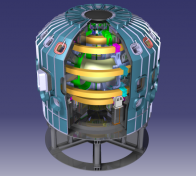Cascaded multilevel inverter for vertical stabilization and radial control power supplies
Nowadays, nuclear fusion energy is one of the greatest challenges in worldwide research. Several international research projects are involved in the development of an actual nuclear fusion energy source structure. In the most promising ones, known as “tokamaks”, a magnetically confined plasma is needed to achieve high rates of fusion reactions.
 The Divertor Tokamak Test (DTT) project (https://www.dtt-project.it/index.php/science/dtt-project.html) aims to create an experimental facility that will have to solve some of the most complex problems on the implementation path of nuclear fusion. The construction of DTT facility is starting within the ENEA Research Center in Frascati, Italy. The mission of the DTT project is to contribute to research on the implementation of nuclear fusion, achieving a plasma current of up to 5.5 MA with a magnetic field of 6 T and additional heating of up to 45 MW coupled to the plasma. The DTT was conceived as a “link” between the large international nuclear fusion projects ITER and DEMO (the reactor that after 2050 will have to produce electricity from nuclear fusion to provide scientific, technical and technological answers to major problems such as the management of the large power flows produced by the plasma exhaust and the materials to be used. In fact, the facility is named after the “divertor”, that is the part of a tokamak devoted to such management.
The Divertor Tokamak Test (DTT) project (https://www.dtt-project.it/index.php/science/dtt-project.html) aims to create an experimental facility that will have to solve some of the most complex problems on the implementation path of nuclear fusion. The construction of DTT facility is starting within the ENEA Research Center in Frascati, Italy. The mission of the DTT project is to contribute to research on the implementation of nuclear fusion, achieving a plasma current of up to 5.5 MA with a magnetic field of 6 T and additional heating of up to 45 MW coupled to the plasma. The DTT was conceived as a “link” between the large international nuclear fusion projects ITER and DEMO (the reactor that after 2050 will have to produce electricity from nuclear fusion to provide scientific, technical and technological answers to major problems such as the management of the large power flows produced by the plasma exhaust and the materials to be used. In fact, the facility is named after the “divertor”, that is the part of a tokamak devoted to such management.
The magnetic system includes several coils necessary to create and control the plasma current. Every coil is supplied by a dedicated power converter topology feeding the high current requested at different voltage levels.
The thesis will develop the converter topologies already identified for the VSS (vertical stabilization Coils) type coils, deepening the different operating conditions and the control system by simulation with the PLECS tool and using the development and verification techniques (testing) called hardware in the loop (HIL). This investigation strategy is implemented with software and hardware tools that reproduce in a more or less complete way the electrical and electronic system to be developed and verified.
Further information in the attached document.
2022_TesiVSS_Tokamak.pdf ![]() (372.94 kB)
(372.94 kB)
Contacts:
Prof. Giovanni Griva (giovanni.griva@polito.it)
Prof. Salvatore Musumeci (salvatore.musumeci@polito.it)
